This article was published in Scientific American’s former blog network and reflects the views of the author, not necessarily those of Scientific American
It’s a well known and oft-repeated ‘rule’ that new animal species have to be based on actual physical specimens, preferably on preserved remains that are accessioned in a recognised biological institute, most typically a museum. The specimen associated with the new species name is termed the type or holotype: it is most often a body (or, the better part of the body) but can be any part of one, or – theoretically – a tissue sample of any kind.
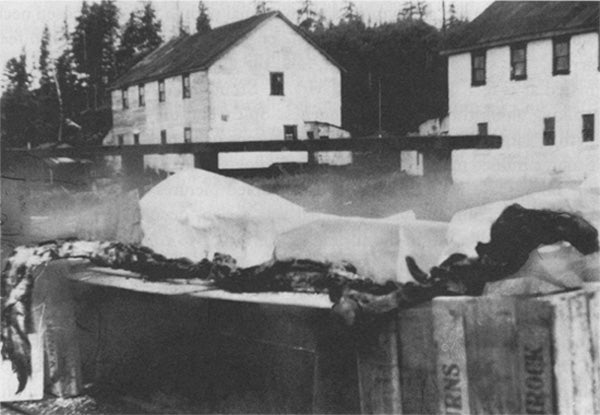
A notorious photo used in the description of a claimed new species. I won't discuss it here - follow the links below if you need to hear the story. Credit: Bousfield & LeBlond 1995
However, what may not be well known outside of zoology is that this ‘rule’ is not as strict and clear as generally thought, and that there is actually some disagreement as to what, exactly, can be accepted as a type specimen. What if you record a new species (via photographic evidence) and decide to declare a live individual as a type specimen? And what if you have a photo of a seeming new species and want to use that as the basis of a new species?
On supporting science journalism
If you're enjoying this article, consider supporting our award-winning journalism by subscribing. By purchasing a subscription you are helping to ensure the future of impactful stories about the discoveries and ideas shaping our world today.
These positions are not purely theoretical. The International Commission on Zoological Nomenclature (or ICZN) is actually somewhat vague on how hard the concept of ‘the holotype’ really is (Dubois & Nemésio 2007, Donegan 2008), several claimed living animal species have been named on the basis of photographic evidence alone, and some experts argue that we should consider or even favour the use of photographic data over the collection of dead bodies (Minteer et al. 2014, Marshall & Evenhuis 2015). No, the species concerned are not universally accepted and most – if not all – are of controversial status. Let’s look at some of them. Naturally, the thoughts here concern tetrapods alone…
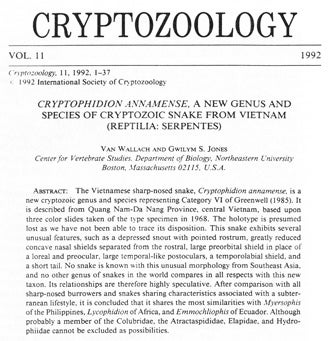
One of the most controversial papers ever published on a small Vietnamese snake. Published in 1994, not 1992! Credit: Wallach & Jones 1994
Cryptophidion anamense is a controversial Vietnamese snake, named in 1994 (not 1992, as stated by virtually everyone*) on the basis of three photos of a single deceased specimen, taken during the Vietnam War by the United States Naval Medical Research Unit. The specimen itself is of unknown whereabouts but there were plans to donate it to the Smithsonian Institution’s National Museum of Natural History (Wallach & Jones 1994). The publication of this claimed new species in the journal Cryptozoology was seen by at least some people interested in research on mystery animals as a good sign: after all, this is good, honest, analytical zoology, right? Alas, it did not take too long for the status of Cryptophidion – sometimes called the Vietnamese sharp-nosed snake – to come under critical scrutiny. Wallach & Jones (1994) argued that Cryptophidion did not match any recognised snake species, and they listed eight characters that seemed to support its distinction. In contrast, Pauwels & Meirte (1996) wrote of their immediate impression that Cryptophidion might actually be the familiar Sunbeam snake Xenopeltis unicolor and went through all of the supposedly diagnostic features listed by Wallach & Jones (1994), arguing that each one could be explained away somehow.
* The journal issue is dated 1992 on its front, but it was published in April 1994. It even says so on the inside cover.
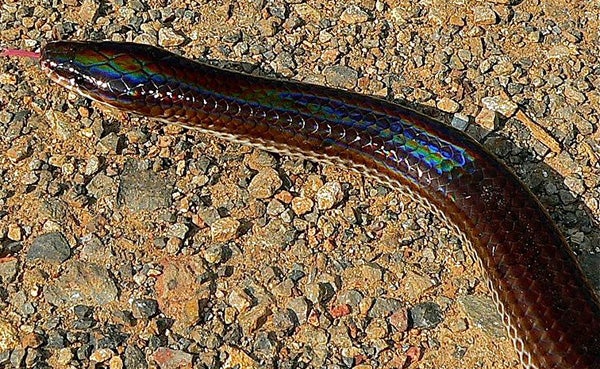
Xenopeltis, the wonderful sunbeam snake. Was Cryptophidion merely a misidentified specimen of this taxon? Image by Bernard Dupont. Credit: Bernard Dupont Flickr (CC BY-SA 2.0)
Case closed? No. This reidentification was challenged by Lazell (1996) and Wallach & Jones (1996), all of whom argued that the specimen was substantially and obviously distinct from Xenopeltis, and that such a proposal was a bit insulting to the expertise of the original authors. Today, most interested parties are aware of Pauwels & Meirte’s (1996) argument that Cryptophidion is synonymous with Xenopeltis, and a consensus view seems to have emerged that Cryptophidion was merely a misidentified Xenopeltis. I have to wonder, however, if the people who follow this have read the Wallach & Jones (1996) response. I’m not a snake specialist but it looks pretty compelling to me. Cryptophidion is not Xenopeltis.
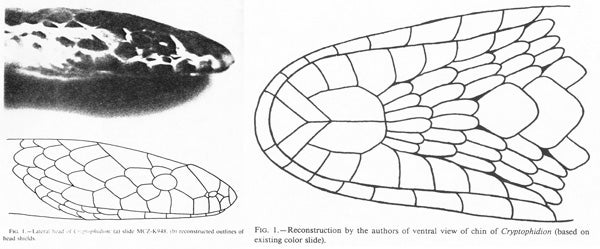
At left, the Cryptophidion holotype as interpreted by Wallach & Jones (1994). They provided another reconstruction since the animal was also photographed from a slightly different angle. At right, the specimen's lower jaw and throat scalation, as figured by Wallach & Jones (1996). This is not a sunbeam snake. Credits: Wallach & Jones 1994, Wallach & Jones 1996
Galápagos pink land iguana Conolophus marthae. Ever since 1986, visitors to Volcan Wolf on Isla Isabela have reported the presence of a seemingly new kind of Galápagos iguana endemic to that volcano, and notable for its remarkable pinkish hue (Gentile et al. 2009). By 2009, sufficient data had been collected for Gentile & Snell (2009) to name it as the new species Conolophus marthae. Not only is the population unusual anatomically, it is the sister taxon to the clade containing all other Galápagos land iguanas, and in fact preserves genetic evidence for one of the oldest evolutionary splits yet reported in endemic Galápagos animals. Predictably enough, the discovery received substantial coverage in the popular media.
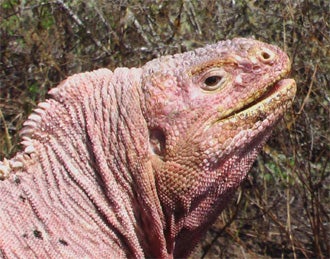
Conolophus marthae specimen (not the holotype) figured by Gentile & Snell (2009). Credit: Gentile & Snell 2009
In describing this species, the authors used a free-roaming male, captured and analysed in 2006, as their holotype: they did not retain a deceased specimen. The animal concerned was branded and tagged with an internally inserted transponder (the plan being to find and retrieve the animal’s corpse after death). And, also predictably enough, this decision was soon criticised, Nemésio (2009) arguing that the methods and procedures used by Gabrile and colleagues should not be followed. It should be noted, however, that the species is not quite in the same ballpark as most of the others discussed here since genetic data was collected: C. marthae was not published on the basis of photos alone.
Yellow-necked parrotlet Forpus flavicollis. In 2010, Bertagnolio & Racheli (2010) proposed the existence of a new species of parrotlet, ‘discovered’ in online photos, taken in Colombia, and depicting captive animals. Their choice of publication venue – Avicultural Magazine – does not seem appropriate for the naming of a new species. Extensive online debate surrounded this proposal, the primary conclusion being that the naming was not valid in the absence of collected specimens.
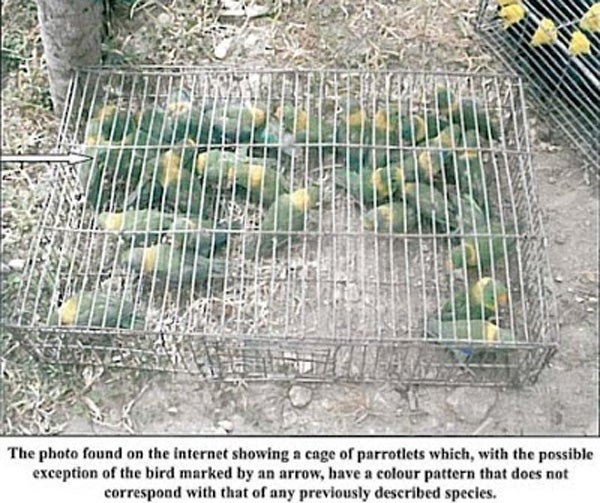
Yellow-necked parrots in captivity as published by Bertagnolio & Racheli (2010). Credit: Bertagnolio & Racheli 2010
Furthermore, the key diagnostic feature of the proposed species – a yellow neck band – might, some proposed, result from the sort of feather-dying already known to be an issue with some Forpus parrotlet specimens from Colombia (Donegan et al. 2011). On the basis of this information, a formal decision to regard the species as not valid was passed by the South American Classification Committee of the American Ornithologists’ Union. Notton (2011) also examined the case; he concluded that the name is technically available, though this does not mean that the entity termed F. flavicollis should be accepted as a real species.
Kipunji Rungwecebus kipunji. During the early years of the 21st century, two different groups of primatologists observed an unusual, long-furred, mangabey-like monkey in Tanzania. This was eventually named as the Highland mangabey or Kipunji, a species originally regarded as part of the mangabey genus Lophocebus (Jones et al. 2005) but later found to belong elsewhere on the family tree and to be worthy of its own generic moniker.
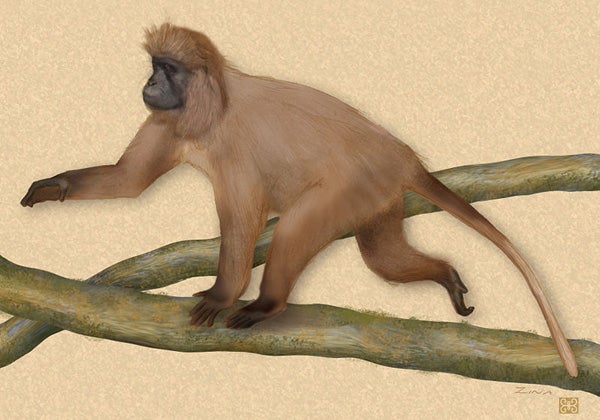
Artwork depicting Kipunji in life. Image by Zina Deretsky, National Science Foundation; image in public domain. Credit: Zina Deretsky National Science Foundation Wikipedia
The big deal about this paper for the purposes of our discussion here is that no holotype was collected, an “Adult male in photograph (Fig. 2)” serving that role. The conservation status of the species was stated as their reason for not collecting a deceased specimen (Jones et al. 2005). None of this went unnoticed and some correspondence followed (Landry 2005, Moser 2005, Polaszek et al. 2005, Timm et al. 2005), certain authors arguing that the taxon should not have been named in the absence of a type specimen. In keeping with what I said above, others contested this, saying that the ICZN does not strictly require a physical type specimen (Polaszek et al. 2005). Others then contested this (Moser 2005). In this particular case, the controversial status of the original naming event is now moot, since deceased specimens have been obtained. I’ve written about this case at length before; see the links below.
Arunachal macaque Macaca munzala. Ever since the late 1990s, a large, robust, dark, short-tailed macaque endemic to Arunachal Province in the far north-east of India was suspected of being a new taxon. This hypothesis was finally stated in detail by Sinha et al. (2005) who named the macaques as the new species M. munzala. Without discussion, their naming was based on photographs alone, and they regarded a photographed individual – still very much alive and living wild – as the holotype (Sinha et al. 2005). Dead specimens (shot by hunters) were procured since the original paper was published. In contrast to virtually all of the other cases discussed here, the publication of M. munzala did not appear to result in debate or discussion in the literature (though it might have; I can’t pretend to keep up with all of the literature).
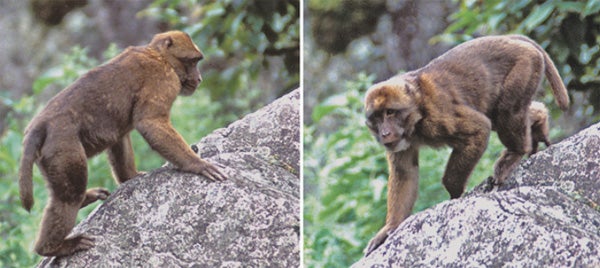
Arunachal macaque photographed in the wild, from Sinha et al. (2005). Credit: Sinha et al. 2005
However, Biswas et al. (2011) collected and compared data on numerous southern Asian macaque populations and did not support distinction of M. munzala relative to the Assamese macaque M. assamensis. The unusual features of the Arunachal population seem to reflect adaptation to a cool, montane environment; it may be an incipient subspecies or species (Biswas et al. 2011).

Blonde capuchin in captivity. Photo by Miguelrangeljr. Credit: Miguelrangeljr Wikipedia (CC BY-SA 3.0)
Blond (or Blonde) capuchin ‘Cebus queirozi’. Numerous new South American monkey species have been named in recent years, both as a consequence of physical discovery in the field and of taxonomic revisions and splits. Among the many is Cebus queirozi, a new capuchin from the Atlantic Forest of Brazil named by Mendes Pontes et al. (2006) (actually, the species name is attributed to Mendes Pontes and Malta alone, two of the three authors… I do wish authors wouldn’t do this. The describers of the Kipunji did the same thing). Mendes Pontes et al. (2006) explained how the new monkey is known from a single social group, comprising 18 individuals, discovered, isolated, in an area dominated by sugar-cane plantations. On the basis of the new species’ “rarity and susceptibility” (they regarded it as “at the very brink of extinction”), they opted not to collect (the euphemism for kill and retain) a specimen, but to photograph a living individual, designate it the holotype, and release it. Indeed they actually cited papers published in the wake of the Kipunji’s description when discussing this decision. End of discussion? Err, no.
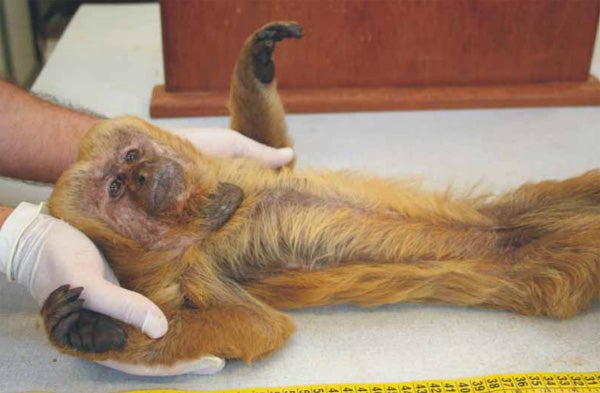
The specimen regarded by Mendes Pontes et al. (2006) as the holotype of the ostensible new taxon Cebus queirozi. Credit: Mendes Pontes et al. 2006
2006 also saw the publication of a paper in which a different set of authors (de Oliveira & Langguth 2006) elected to formally recognise a capuchin species that had long been known but was lacking a formally elected type specimen, namely the Caitaia C. flavius, a monkey known to European naturalists of the 1600s. It is now generally agreed that C. flavius and C. queirozi are the same species, with C. flavius having priority. The original claim that C. queirozi was both novel and persisting as but a tiny relict population are, therefore, no longer correct, though note that the species is still critically endangered. Recent taxonomic revisions have provided support for the idea that the capuchin group that includes this species should be separated from Cebus and recognised as the distinct genus Sapajus.
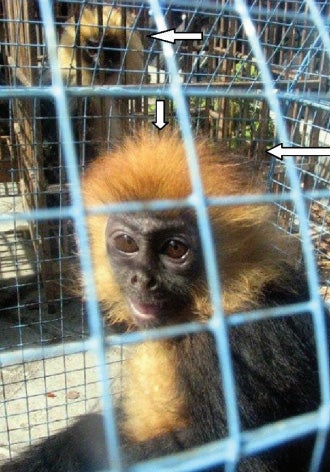
Two of the Golden-crowned langur specimens discovered and discussed by Nardelli (2015). Credit: Nardelli 2015
Golden-crowned langur Presbytis johnaspinalli. One of the most curious cases discussed here concerns the captive monkeys, originally ‘discovered’ in photos online, and named as a new species by Nardelli (2015). Nardelli (2015) argued that these animals – seemingly originating from Sumatra, and discovered in various animal collections – do not match any recognised species, and have a form and pelage consistent with inclusion in the monkey genus Presbytis, the surilis. Thus a new species was named on photos alone.
Once again, it did not take long for this proposal to be challenged. Nijman (2015) argued that the animals were not Presbytis monkeys, but instead have features (most notably an anteriorly directed fringe of head hair) more typical of Trachypithecus, the lutungs. Furthermore, their unusual colouration more plausibly resulted from the deliberate bleaching performed by unscrupulous animal dealers aiming to increase the value of their wares. Furthermore, the monkeys, Nijman argued, can be identified as Ebony langurs T. auratus from Java. It should also be noted that – as excellent and respected as International Zoo News is as a publication – it is really not the appropriate venue for the naming of a new species.
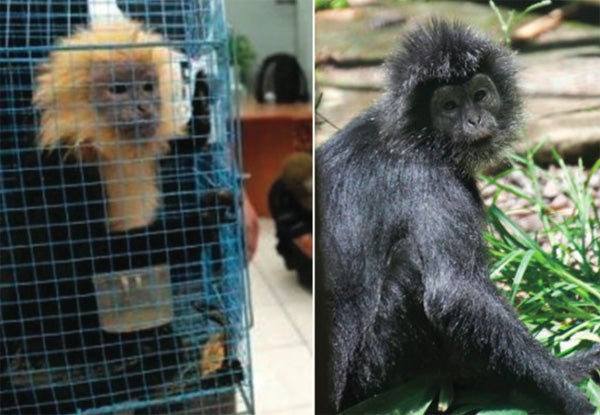
Are specimens of the 'Golden-crowned langur' (at left) really just bleached specimens of the Ebony langur? Such has been argued by Nijman (2015). Credit: Nijman 2015
White-cheeked macaque Macaca leucogenys. Yes, another macaque, and another claimed species from the same general region as that inhabited by the Arunachal macaque. M. leucogenys was named by Li et al. (2015) for specimens observed and captured in southeastern Tibet, and regarded as distinct on the basis of various features of pelage, skin colour and penis shape. Again, this naming was done on the basis of photographic evidence and a physical specimen was not collected; the authors noted “ethical concerns” as goes the killing of a specimen, and they cited the naming of M. munzala and the Kipunji as precedents. At the time of writing, I’m not aware of published criticisms of this still very new study.
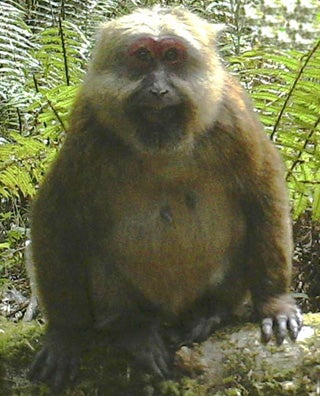
White-cheeked macaque specimen photography via camera-trap. Image from Li et al. (2015). Credit: Li et al. 2015
Worth noting is that Li et al. (2015) regarded M. munzala as a valid species: they noted Biswas et al.’s (2011) argument that the macaques of the region actually represent anatomically variable, evolving populations of the Assamese macaque M. assamensis, but merely said how this study indicated the existence of unresolved taxonomic issues.
This list of species is far from complete – I may discuss other relevant cases in another article. But a few things stand out even from the handful discussed so far. It’s not a coincidence that most of the animals discussed here are primates. More than any other group of animals, those who work on them strive not to kill the animals they study, for obvious reasons (by which I mean those involving ethics and empathy).
Note also that the decision to name a species without collecting a holotype or from photographic evidence alone has, all too often, been problematic. The validity of the species concerned itself forms the subject of extensive discussion, issues of anatomical distinction that ideally need resolution via access to physical specimens become paramount, and issues concerning low standards and even fraud and trickery are sometimes raised.
And yet – I agree with those who argue that photography can sometimes be sufficient in such cases, and indeed might even be necessary. For that to work – and it’s something that’s being discussed more and more (e.g., Minteer et al. 2014, Marshall & Evenhuis 2015, Ceriaco et al. 2016) – we need high standards. Fuzzy shots of animals photographed at distance will not do.
For previous Tet Zoo articles relevant to the issues mentioned here, see...
The kipunji, and new light on the evolution of drills, mandrills and baboons
A baby sea-serpent no more: reinterpreting Hagelund’s juvenile Cadborosaurus
Refs - -
Bertagnolio, P. & Racheli, L. 2010. A new parrotlet from Colombia, Forpus flavicollis. Avicultural Magazine 116, 128-133.
Biswas, J., Borah, D. K., Das, A., Das, J., Bhattacharjee, P. C., Mohnot, S. M. & Horwich, R. H. 2011. The enigmatic Arunachal macaque: its biogeography, biology and taxonomy in northeastern India. American Journal of Primatology 73, 1-16.
Ceriaco, L. M. P., Gutierrez, E. E. & Dubios, A. 2016. Photography-based taxonomy is inadequate, unnecessary, and potentially harmful for biological sciences. Zootaxa 4196, 435-445.
de Oliveira, M. M. & Langguth, A. 2006. Rediscovery of Marcgrave’s capuchin monkey and designation of a neotype for Simia flavia Schreber, 1774 (Primates, Cebidae). Boletim do Museu Nacional: Nova Série: Zoologia 523, 1-16.
Donegan, T. M. 2008. New species and subspecies descriptions do not and should not always require a dead type specimen. Zootaxa 1761, 37-48.
Donegan, T. M., Quevedo, A., McMullan, M. & Salaman, P. 2011. Revision of the status of bird species occurring or reported in Colombia 2011. Conservación Colombiana 15, 4-21.
Dubois, A. & Nemésio, A. 2007. Does nomenclatural availability of nomina of new species or subspecies require the deposition of vouchers in collections? Zootaxa 1409, 1-22.
Gentile, G., Fabiani, A., Marquez, C., Snell, H. L., Snell, H. M., Tapia, W. & Sbordoni, V. 2009. An overlooked pink species of land iguana in the Galápagos. Proceedings of the National Academy of Sciences 106, 507-511.
Jones, T., Ehardt, C. L., Butynski, T. M., Davenport, T. R. B., Mpunga, N. E., Machaga, S. J. & De Luca, D. W. 2005. The Highland mangabey Lophocebus kipunji: a new species of African monkey. Science 308, 1161-1164.
Landry, S. O. 2005. What constitutes a proper description? Science 309, 2164.
Lazell, J. D. 1996 (for 1993). Cryptophidion is not Xenopeltis (response to Pauwels & Meitre). Cryptozoology 12, 101-102.
Marshall, S. A. & Evenhuis, N. L. 2015. New species without dead bodies: a case for photo-based descriptions, illustrated by a striking new species of Marleyimyia Hesse (Diptera, Bombyliidae) from South Africa. ZooKeys 525, 117-127.
Minteer, B. A., Collins, J. P. & Puschendorf, R. 2014. Avoiding (re)extinction. Science 344: 260-261.
Moser, M. 2005. Holotypic ink. Science e-letters http://www.sciencemag.org/cgi/eletters/309/5744/2163c
Nardelli, F. 2015. A new Colobinae from the Sundiac region: the Golden-crowned langur Presbytis johnaspinalli, sp. nov. International Zoo News 62, 323-336.
Nijman, V. 2015. Rebuttal to Presbytis johnaspinalli. International Zoo News 62, 403-406.
Notton, D. G. 2011. The availability and validity of the name Forpus flavicollis (Bertagnolio and Racheli 2010), for a parrotlet from Columbia. Bulletin of the British Ornithologists’ Club 131, 221-224.
Pauwels, O. & Meirte, D. 1996 (for 1993). The status of Cryptophidion annamense. Cryptozoology 12, 95-101.
Polaszek, A., Grubb, P., Groves, C., Ehardt, C. L. & Butynski, T. M. 2005. What constitutes a proper description? Response. Science 309, 2164-2166.
Timm, R. M., Ramey, R. R. & The Nomenclature Committee of the American Society of Mammalogists. 2005. What constitutes a proper description? Science 309, 2163-2166.
Wallach, V. & Jones, G. S. 1994 (for 1992). Cryptophidion annamense, a new genus and species of cryptozoic snake from Vietnam (Reptilia: Serpentes). Cryptozoology 11, 1-37.
Wallach, V. & Jones, G. S. 1996 (for 1993). Cryptophidion is a valid taxon (response to Pauwels & Meitre). Cryptozoology 12, 102-113.